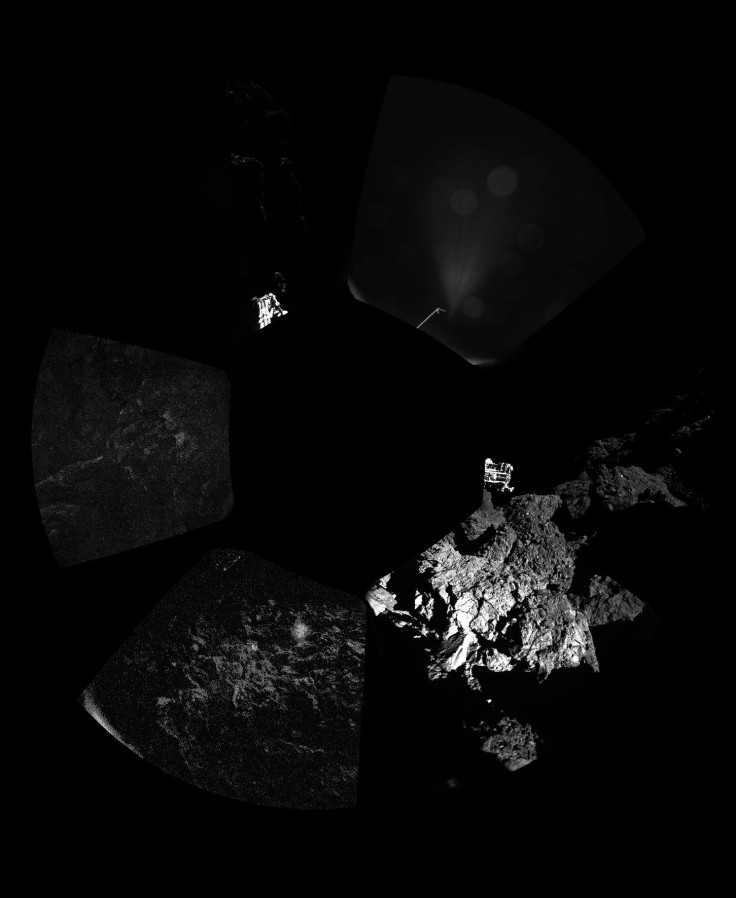Rosetta Mission: Philae Goes Into Slumber After Sending Data From Comet 67P

After nearly 57 hours on Comet 67P/Churyumov–Gerasimenko, the European Space Agency's Philae lander has gone to sleep with the power from its solar-powered batteries drained out.
However, it has sent unprecedented images and data of its surroundings, says an ESA release.
All 10 instruments on board the lander were kicked into action and frenziedly carried out science experiments in the hours prior to the hibernation. These include probing the comet's density, temperature and atmosphere.
While most of this was carried out, including the drilling, only analysis of the data received will tell how useful they are.
Having landed in a place different from what was intended, there was no way Philae could be tracked by Rosetta constantly and there were only two communication windows every day.
The last opened around 2130 GMT on Friday and closed at 0036 GMT the next morning as Rosetta disappeared in orbit behind the comet.
The images have already delivered glimpses showing the surface of the comet is covered by dust and debris ranging from a small millimetre to metre sizes, while panoramic images show layered walls of harder-looking material.
After bouncing twice, Philae landed in the shadow of a cliff that blocked sunlight from powering its batteries.
"It has been a huge success, the whole team is delighted," said Stephan Ulamec, lander manager at the DLR German Aerospace Agency, who monitored Philae's progress from ESA's Space Operations Centre in Darmstadt, Germany, this week.
Sleeping lander may come awake
"We still hope that at a later stage of the mission, perhaps when we are nearer to the Sun, that we might have enough solar illumination to wake up the lander and re-establish communication, " added Stephan.
No contact will be possible with the lander unless sufficient sunlight falls on the solar panels to generate enough power to wake it up.
Mission controllers sent commands to rotate the lander's main body with its fixed solar panels and there is hope that this should have exposed more panel area to sunlight.
After being out of communication visibility with the lander since 09:58 GMT / 10:58 CET on Friday, Rosetta regained contact with Philae at 22:19 GMT /23:19 CET on Saturday night. The signal was initially intermittent, but quickly stabilised and remained very good until 00:36 GMT / 01:36 CET on Saturday morning.
During that time, the lander returned all of its housekeeping data, as well as science data from all its instruments.
Meanwhile, the Rosetta orbiter has been moving back into a 30 km orbit around the comet.
It will return to a 20 km orbit on 6 December and continue its mission to study the body in great detail as the comet becomes more active, en route to its closest encounter with the sun on 13 August next year.
Beyond expectations
When Rosetta was originally designed more than a decade ago, the comet lander Philae was conceived of as a 24-hour mission, Alan Stern of the Southwest Research Institute in Boulder, Colorado, and member of the Rosetta science team, told National Geographic.
The lander detached from the Rosetta spacecraft orbiting 22 km above comet 67P Churyumov–Gerasimenko on Wednesday, landing on the 5-km-long comet the same day, in what is described as nothing short of a space feat.
Gravity on the comet being very weak, Philae which weighs 85 kg, weighs about an ounce on the comet, causing it to bounce off twice before falling on its side.
Japan's Hayabusa spacecraft, which landed on an asteroid in 2005, encountered similar travails when its Minerva lander drifted into space instead of staying put.
Comets are ancient relics residing outside the solar system and believed by some scientists to have seeded life and water on earth.
© Copyright IBTimes 2025. All rights reserved.





















